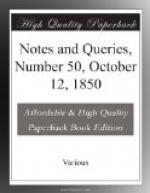as an appropriate portion of his personal insignia.”
From which it may be inferred, that the only existent
real difference between the crozier and the pastoral
staff is, that the former is surmounted by a cross,
and the latter is as it was before the 12th century,
viz., surmounted by “a head curled round
something in the manner of a shepherd’s crook;”
and the difference in regard to their use, that the
crozier pertains to the archbishops, and the pastoral
staff to the bishops.
R.W. ELLIOT
Cheltenham, Sept. 16. 1850.
* * * * *
PARSONS, THE STAFFORDSHIRE GIANT.
(Vol. ii., p. 135.)
Harwood’s note in Erdeswick’s Staffordshire, quoted by your correspondent C.H.B., is incorrect, inasmuch as the writer has confused the biographies of two distinct “giants”—WALTER PARSONS, porter to King James I., and WILLIAM EVANS, who filled the same office in the succeeding reign.
The best account of these two “worthies” is that found in Fuller, and which I extract from the original edition now before me:—
WALTER PARSONS, born in this county [Staffordshire], was first apprenticed to a smith, when he grew so tall in stature, that a hole was made for him in the ground to stand therein up to the knees, so to make him adequate with his fellow-workmen. He afterwards was porter to King James; seeing as gates generally are higher than the rest of the building, so it was sightly that the porter should be taller than other persons. He was proportionable in all parts, and had strength equal to height, valour to his strength, temper to his valour, so that he disdained to do an injury to any single person. He would make nothing to take two of the tallest yeomen of the guard (like the Gizard and Liver) under his arms at once, and order them as he pleased.
“Yet were his parents (for aught I do understand to the contrary) but of an ordinary stature, whereat none will wonder who have read what St. Augustine (De Civitate Dei, lib. xv. cap. 23.) reports of a woman which came to Rome (a little before the sacking thereof by the Goths), of so giant-like a height, that she was far above all who saw her, though infinite troopes came to behold the spectacle. And yet he addeth, Et hoc erat maximae admirationis, quod ambo parentes ejus, &c. This made men most admire, that both her parents were but of ordinary stature. This Parsons is produced for proof, that all ages afford some of extraordinary height, and that there is no general decay of mankind in their dimensions, which, if there were, we had ere this time shrunk to be lower than Pigmyes, not to instance in a lesse proportion. This Parsons died Anno Dom. 1620.”—Fuller’s History of the Worthies of England, 1662 (Staffordshire),




